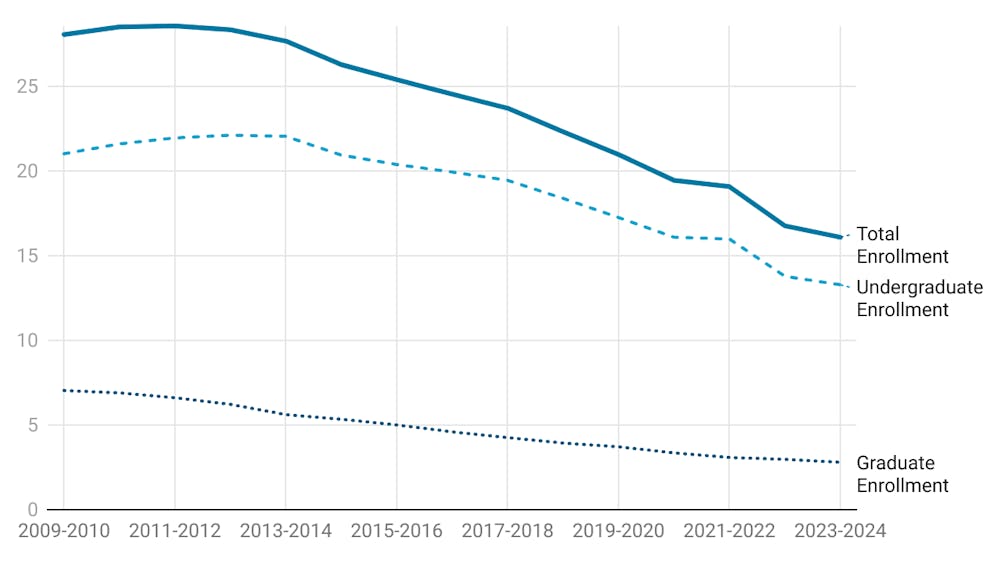The truth behind Eastern Michigan University students—driving forces for attendance, academic feedback, student demographics and more—was revealed by two annual, national surveys.
At a Division Council meeting Wednesday morning, the Office of Institutional Research and Information Management (IRIM) presented the recent results of The Freshman Survey (Cooperative Institutional Research Program—CIRP) and the National Survey of Student Engagement (NSSE), both of which gave crucial insight into EMU’s student body, especially many of its financial scenarios.
Reasons for choosing Eastern and expectations were first revealed by CIRP results. The survey was given only to ‘first time in any college’ students at the Fast Track orientation in August.
The outcome was slightly predictable; FTIACs appreciate the affordability above all else (typically, price is a high-ranked element).
But the survey brought up an interesting point—more students choose Eastern for its bargain price than at any other peer institute (additional
4-year colleges that participated).
The academic reputation of the Ypsilanti university was the next most common reason, with financial assistance, job opportunities after graduation and a visit to campus following.
Reasons given for attending college, in general, were on-par with other peers. Most participants said a degree would help get a better job as well as provide training for a future career. Less EMU students than at peer institutes, however, predicted they’d need to transfer to a different college before graduation.
Freshman Michelle Tulley, who participated in August, said she feels satisfied with EMU already.
“I’m excited to see what else I can take,” said Tulley, an art student. “I’ll eventually be finished with my general courses, and then I can start taking the really fun stuff. I’m worried I won’t be able to afford living away from home much longer, though!”
Compared to ‘peers,’ more Eastern FTIAC’s predicted they’d need a job (even a full-time one, according to a sector) to help pay expenses.
Conversely, that number has dropped since last year.
In Bin Ning’s opinion, CIRP scores reflected in a specific recommendation: more direction should be give to new students, especially transfers and FTIAC’s.
“We should help them get more engaged with campus activities,” said Bing, Assistant Vice President and Executive Director of IRIM. “They should have a little more interaction with faculty to adjust.”
Next, student engagement, defined in NSSE as, “The time and energy devoted to studies and other educationally purposeful activities,” was evaluated. Every spring first-year and senior students are asked to partake in the online analysis.
Time usage results were most interesting. More EMU seniors than normal work off campus and, as a result, spend far less time preparing for class (studying, reading and writing) or participating in co-curricular activities.
This could be attributed to the fact that an above-average number of Eastern students provide care for dependents whom they live with and dedicate more time to family responsibilities.
It goes hand-in-hand with age, too. Undergraduate and graduate students combined, the average age at EMU just barely passes 26. At similar schools, the age is lower.
Senior Kyndra Bryson offered an explanation for this.
“We’re trying to work here,” Bryson said. “So on average, it probably takes longer for us to graduate. I can understand that. Both myself and my two siblings are taking longer than we expected. It has seemed impossible to graduate on time.”
The NSSE also proved students’ overall satisfaction indicated considerable progress from 2008 to 2011. There was a higher percentage on the “excellent” rating. More students think EMU provided “excellent” quality of education, while fewer students think the quality is “poor.” Both types of students reported higher satisfaction on all three items across four years.
Ning pointed out that although the voluntary surveys bring light to different elements, both are critical in identifying students.
“In general, we have done a lot of positive things in analyzing the data,” Ning said. “It shows we have developed more stable environments in teaching and learning.”
He continues to hope for more student involvement, though.
“We want students to participate so we can use the information to help them,” Ning said.
Eastern experienced a slight increase in the number of NSSE participants from the previous year, but demographically, the number remains lower than average. This year, NSSE institutions received a 34 percent response rate collectively. Eastern received only 23 percent.
According to Ning, colleges with similar enrollment offering master’s programs were selected to participate in the national surveys. This included nearby locations like Kent State University (Kent, Ohio) and Oakland University (Rochester, Mich.), and distant ones like California State University (Sacramento, Calif.) and The University of Texas (San Antonio, Texas).







